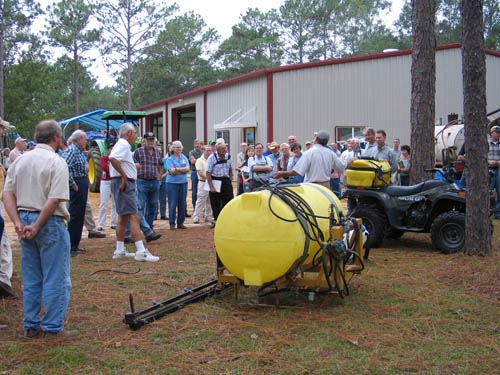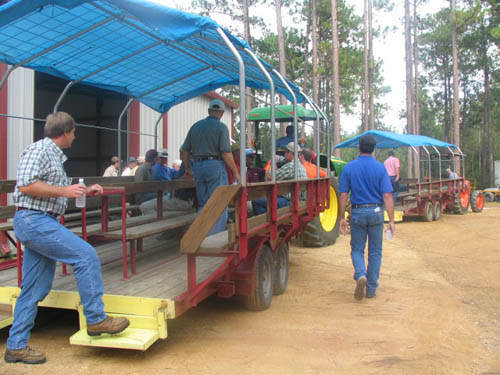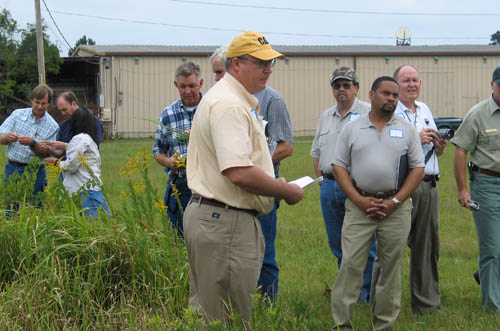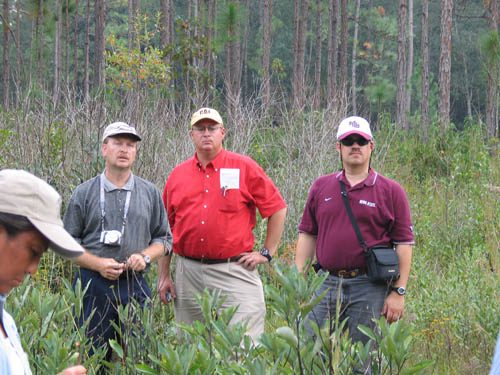Mississippi Invasive Species Alliance Tour Held
November 8, 2004 The GeoResources Institute (GRI) of Mississippi State University recently hosted a tour and informational meeting on invasive species management for restoration of lower coastal plain ecosystems. The tour was co-sponsored by the Mississippi Invasive Species Alliance, the Southern Weed Science Society, and BASF. Approximately 50 participants from federal, state, and local government agencies throughout the Southeast attended the tour during the three days, October 6-8, 2005, representing activities in the mid-south states of Alabama, Arkansas, Louisiana, Mississippi, and Tennessee.
The GeoResources Institute (GRI) of Mississippi State University recently hosted a tour and informational meeting on invasive species management for restoration of lower coastal plain ecosystems. The tour was co-sponsored by the Mississippi Invasive Species Alliance, the Southern Weed Science Society, and BASF. Approximately 50 participants from federal, state, and local government agencies throughout the Southeast attended the tour during the three days, October 6-8, 2005, representing activities in the mid-south states of Alabama, Arkansas, Louisiana, Mississippi, and Tennessee.On Wednesday October 6, the tour began with an in-depth examination of Longleaf Pine restoration on the Judd Brooke's Plantation near Necaise, MS. Participants received an up-close view of the interrelationship between land management, invasive species management, wildlife management and economics in the restoration of this significant community. Longleaf pine restoration and management involves a close working relationship between the private landowner and county, state, and federal agencies.
 On the second day of the tour, participants had a full day of activities. The day began by viewing how important the link between university research, extension and outreach, and resource management agency collaboration can be in the battle with invasive species. Cogongrass management research plots were the first stop, with an informational presentation by the study director, Dr. John Byrd of Mississippi State University. Herbicide application rates and product selections developed by research plots were then used in interagency demonstrations near Pascagoula, a cooperative project of MS Department of Transportation, Mississippi Department of Environmental Quality, and Mississippi State University. After lunch, we viewed the Mississippi Department of Transportation's efforts to control Chinese Privet along highway rights of way in southern Mississippi, and the tropical soda apple project eradication efforts in the joint program of USDA APHIS and Mississippi Department of Agriculture and Commerce, Bureau of Plant Industry.
On the second day of the tour, participants had a full day of activities. The day began by viewing how important the link between university research, extension and outreach, and resource management agency collaboration can be in the battle with invasive species. Cogongrass management research plots were the first stop, with an informational presentation by the study director, Dr. John Byrd of Mississippi State University. Herbicide application rates and product selections developed by research plots were then used in interagency demonstrations near Pascagoula, a cooperative project of MS Department of Transportation, Mississippi Department of Environmental Quality, and Mississippi State University. After lunch, we viewed the Mississippi Department of Transportation's efforts to control Chinese Privet along highway rights of way in southern Mississippi, and the tropical soda apple project eradication efforts in the joint program of USDA APHIS and Mississippi Department of Agriculture and Commerce, Bureau of Plant Industry.After these tour stops, participants returned to the Judd Brooke's Plantation to view local education and outreach efforts on cogongrass management and longleaf pine restoration. This portion of the program,
 the Forestry and Wildlife Field Day, was an effort by Hancock County, Mississippi State University Extension Service, and USDA Natural Resource Conservation Service and USDA Forest Service for management of private forests. Presenters included representatives from US Fish and Wildlife Service, USDA Natural Resources Conservation Service, Mississippi Forestry Commission, Mississippi State University and Extension Service, The Nature Conservancy, BASF, and private consultants. Field tour topics included cogongrass management, longleaf pine forest management, conversion of slash pine to longleaf pine forests, plant diversity and the importance of blanket bogs in the longleaf pine ecosystem, demonstration of mechanical and chemical forestry management practices, and federal cost share programs. Over 100 landowners and local residents came to participate in this informational tour, which was followed by a catfish dinner and presentations on invasive species, wildlife management, and remote sensing.
the Forestry and Wildlife Field Day, was an effort by Hancock County, Mississippi State University Extension Service, and USDA Natural Resource Conservation Service and USDA Forest Service for management of private forests. Presenters included representatives from US Fish and Wildlife Service, USDA Natural Resources Conservation Service, Mississippi Forestry Commission, Mississippi State University and Extension Service, The Nature Conservancy, BASF, and private consultants. Field tour topics included cogongrass management, longleaf pine forest management, conversion of slash pine to longleaf pine forests, plant diversity and the importance of blanket bogs in the longleaf pine ecosystem, demonstration of mechanical and chemical forestry management practices, and federal cost share programs. Over 100 landowners and local residents came to participate in this informational tour, which was followed by a catfish dinner and presentations on invasive species, wildlife management, and remote sensing. On the third and final day of the tour, the Mississippi Invasive Species Alliance hosted an informational and organizational meeting to discuss the possible formation of a Mid-south Invasive Species Alliance. Twenty-two invited participants from state and federal agencies from Alabama, Arkansas, Louisiana, Mississippi and Tennessee attended this meeting. Dr. David Shaw (GRI) and Dr. Randy Westbrooks (US Geological Service Biological Resources Discipline) first discussed the impetus for a regional effort at cooperation and coordination between agencies and groups focused on all invasive species efforts. These presentations were followed by a state-by-state discussion of invasive species management activities. The attendees agreed to the need for an effort between these states and the diverse efforts on managing invasive species to cooperate and coordinate more fully, and outlined future steps to take towards a more formal organization.
On the third and final day of the tour, the Mississippi Invasive Species Alliance hosted an informational and organizational meeting to discuss the possible formation of a Mid-south Invasive Species Alliance. Twenty-two invited participants from state and federal agencies from Alabama, Arkansas, Louisiana, Mississippi and Tennessee attended this meeting. Dr. David Shaw (GRI) and Dr. Randy Westbrooks (US Geological Service Biological Resources Discipline) first discussed the impetus for a regional effort at cooperation and coordination between agencies and groups focused on all invasive species efforts. These presentations were followed by a state-by-state discussion of invasive species management activities. The attendees agreed to the need for an effort between these states and the diverse efforts on managing invasive species to cooperate and coordinate more fully, and outlined future steps to take towards a more formal organization.For information on the Mississippi Invasive Species Alliance, or to find out more about regional efforts and the formation of a Mid-South Invasive Species Alliance, contact
Dr. John Madsen
GeoResources Institute
Box 9652
Mississippi State, MS 39762
662-325-2428
jmadsen@gri.msstate.edu.
